Journal Portlets
The Journal application is composed of four portlets:
Journal
-
Is an administration portlet that allows the creating, updating searching and managing contents.
Journal Articles
-
Allows displaying of a set of contents that satisfy a set of conditions configured through the portlet preferences such as content type and community.
Journal Content
-
Allows displaying one or more contents manually selected from the list of available portlets. If more than one content is selected only one at a time will be shown and links will be added to allow the user to navigate to the rest of the contents.
Journal Content Search
-
Allows users to search for Journal content.
the Journal portlet is used to create all CMS content and the Journal Articles and Journal Content portlets are used to display those contents. This portlet allows writers to easily edit content displayed on web pages without having to sort through complex code.
Definitions
Before getting into the details of how to use the Journal portlet, it is useful to understand structures, templates, and articles; they are the backbone of the Journal portlet's functionality.
-
Structures define the type and number of content pieces (e.g. text, text area, images, selection lists, etc.)
-
Templates determine how content pieces will be arranged or laid out
-
Articles are where each content piece is populated with actual text and images
The point of a structure is to unify journal articles with the same numbers and types of items. For example, a Management Bio section of a website might have ten biographies, each requiring an image for the executive headshot, a text for the headline, and a text area for the main biography. A structure would be created with one image, one text, and one text area, each named accordingly. This allows writers to create the individual biographies and other texts without needing to recreate the page structure for each biography.
Designers can create several templates for one structure to allow for a variety of presentations or they can give writers discretion in deciding the best layout.
All specific text and images are entered when a user adds or edits an article. This is also where a user chooses the layout based on the templates affiliated with a structure. Since multiple templates can be associated to a structure, the user can select the template that formats their article the way they want.
 To add a Journal Portlet to the Page
To add a Journal Portlet to the Page
-
Login to WebSynergy.
-
Click Add Applications and expand the CMS folder.
-
Click Add against the Journal Portlet.
The Journal Portlet is added to your page.
Figure 4–25 Journal Portlet

The user interface of the portlet contains Articles, Structures, Templates, Feeds and Recent tabs. You can search documents using the Search Articles button in the Articles tab. You can add an article using the Add Article button.
-
Click the Articles tab to view all currently available Journal Articles.
Figure 4–26 Journal Articles displayed in the Journal portlet

Structures
 To create a Structure
To create a Structure
-
To create a structure, first click on the Structures tab in the Journal Portlet, and then click on the Add Structure button. The structure creation page is displayed.
Specify an ID, or Select the Autogenerate ID checkbox for the system to generate an ID. It is recommended that you choose your own ID so that the structure will be easier to identify when associating it with templates and articles. The convention is to separate words in the ID with a hyphen, e.g., “BASIC-STRUCTURE-NAME.” The structure ID can not be changed once your structure has been saved, so be sure that the ID is exactly how you would want it to appear.
Enter a name and a description for the structure.
To start adding fields to the structure, click the Add Row button. This will show a new field where you can enter a name and a content type for this field (image, text, boolean flag, etc.). Those comfortable with XML or HTML can edit the XSL directly by clicking Launch Editor. Both methods of adding/editing elements will work, and both can be used in the same session. One simple approach is to add a few elements using the GUI and then to edit the XML directly (which will contain the syntax for the already added elements and can be copy-pasted).
Empty spaces are not allowed within a field name. Rows can be moved up or down by clicking on Arrow buttons. You can use the Plus button to add a row.
Figure 4–27 To create a Structure

-
Click Save.
The Structure is created successfully.
Figure 4–28 To create a Structure
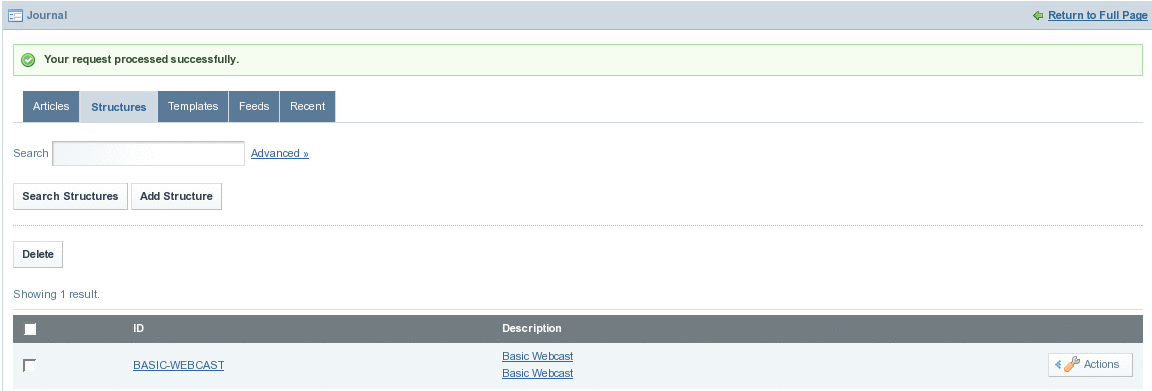
 To Edit a Structure
To Edit a Structure
-
Click on Actions tab against the Structure, and select Edit from the menu.
Figure 4–29 To edit a Structure
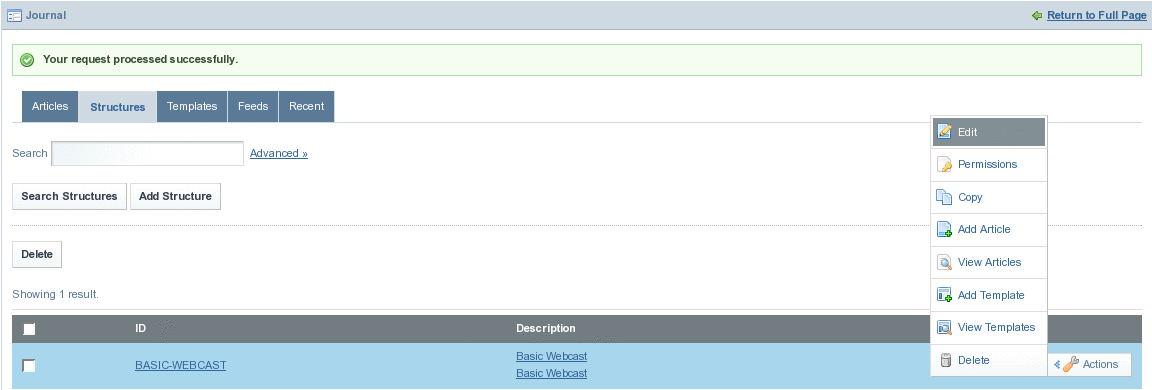
The Structure opens in Edit mode.
Figure 4–30 To edit a Structure
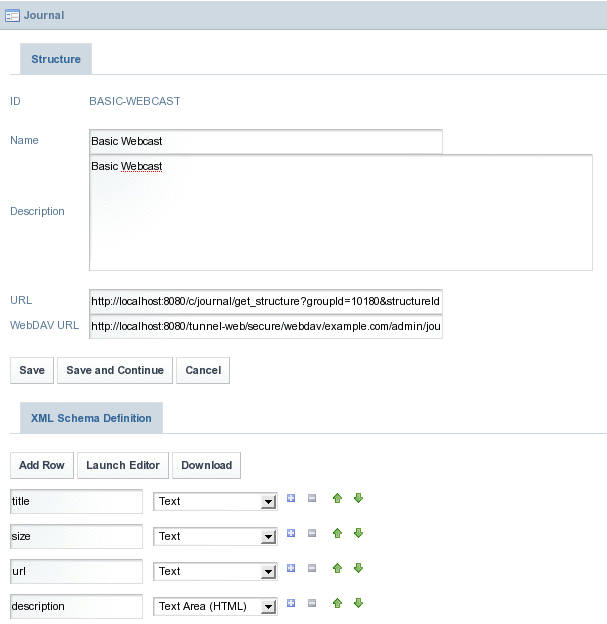
In the edit screen, you can edit anything in the structure except for the structure ID, which can not be changed once the structure has been created.
Editing the name and description will not affect other features of the Journal portlet, but adding, deleting, and modifying fields will affect the templates and articles that are associated with the structure. It is advisable to backup the current XML file first by clicking the Download button so that it will be easy to revert to your old structure if necessary.
If you add fields, the articles associated will have extra fields for additional content. If you delete fields, associated content in associated articles will be deleted. For example, an article using the template Basic Webcast has title, size, url and description fields, as these are the fields available on the template.
Figure 4–31 To edit a Structure
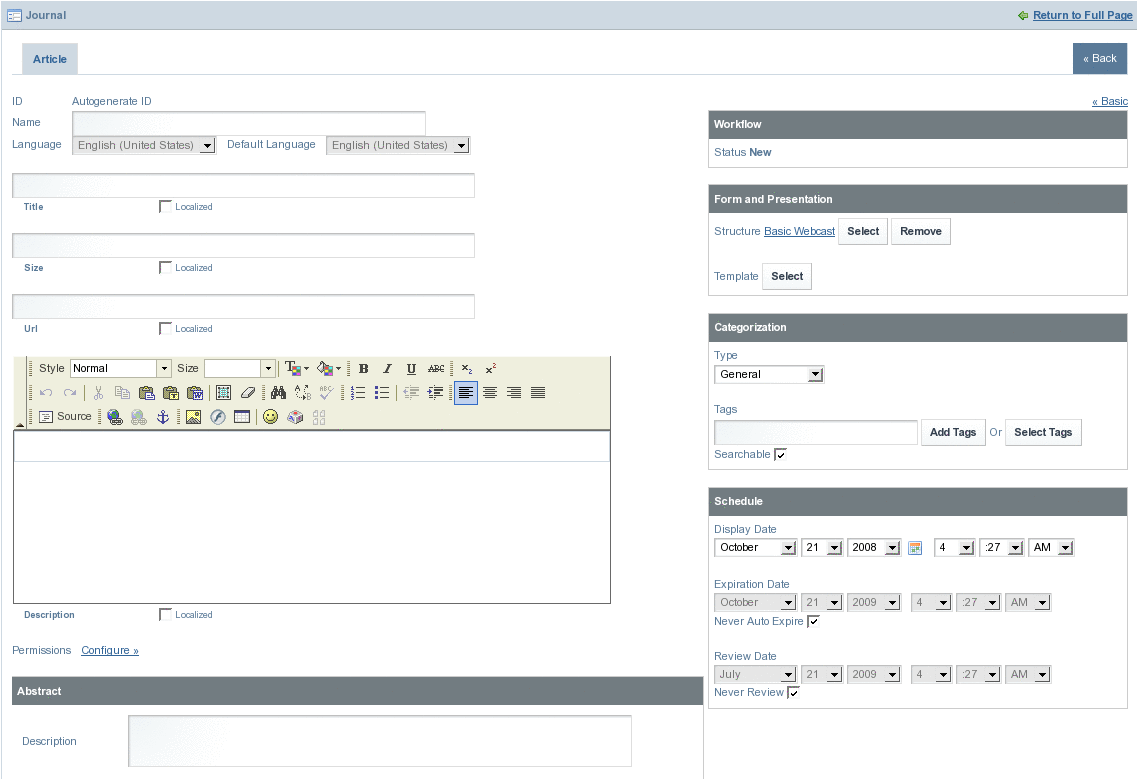
-
Make desired changes to the Structure, and click Save to save changes.
 To Delete a Structure
To Delete a Structure
-
To delete a structure, you must first delete all articles and disassociate or delete all templates associated with that structure.
To delete all articles, click on the Actions button and select View Articles from the menu.
Figure 4–32 To delete a Structure
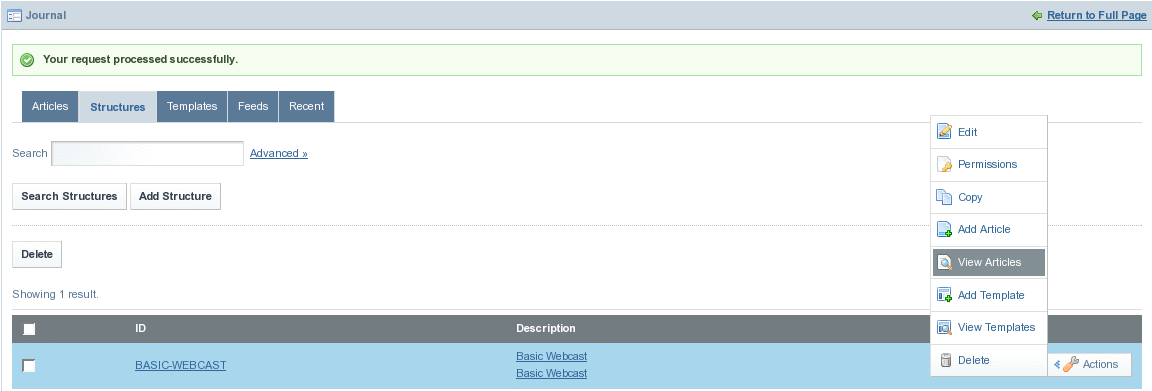
All the articles associated with the Structure are listed.
Figure 4–33 To delete a Structure

-
Select all articles, and click on the Delete button.
-
Click on the Structure tab again. Click on the Actions button against the Structure, and select View Templates from the menu.
All the templates associated with the structure are listed.
Figure 4–34 To delete a Structure

You can delete all the Templates associated with the Structure. To do this, select all Templates and then click the Delete button.
-
Select the Structure and click on the Delete button to delete the template.
Alternatively, you click Delete from the menu appearing on clicking the Actions button.
Figure 4–35 To delete a Structure

Templates
 To Create a Template
To Create a Template
-
Login to WebSynergy.
-
Click Add Applications and expand the CMS folder.
-
Click Add against Journal portlet.
The Journal portlet is added to your page.
-
Click on the Templates tab.
Click the Add Template button to create a template. The Template page appears.
Figure 4–36 To create a Template

-
Specify an ID, Name and Description for the template. Click the Select button to select a Structure for the template.
The Select and Remove buttons against the Structure field can be used to associate or to disassociate a structure from the Template.
Figure 4–37 To create a Template

A window for selecting Structures is launched.
-
Click on name of the Structure to select it.
In our example, click on BASIC-WEBCAST. The Structure is selected.
Figure 4–38 To create a Template
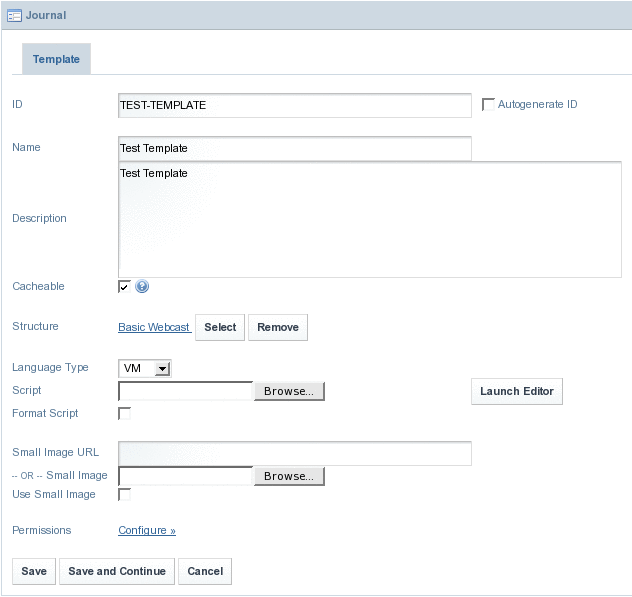
-
To edit the template layout content, you can use one of two methods:
-
To create a completely new template:
-
Click the Launch Editor button.
An Editor pops-up. You can select an Editor Type. Plain and Rich are the two available editor types. Plain is the default editor type, but you can select Rich, as it is easier to work with Rich editor.
Figure 4–39 To create a Template
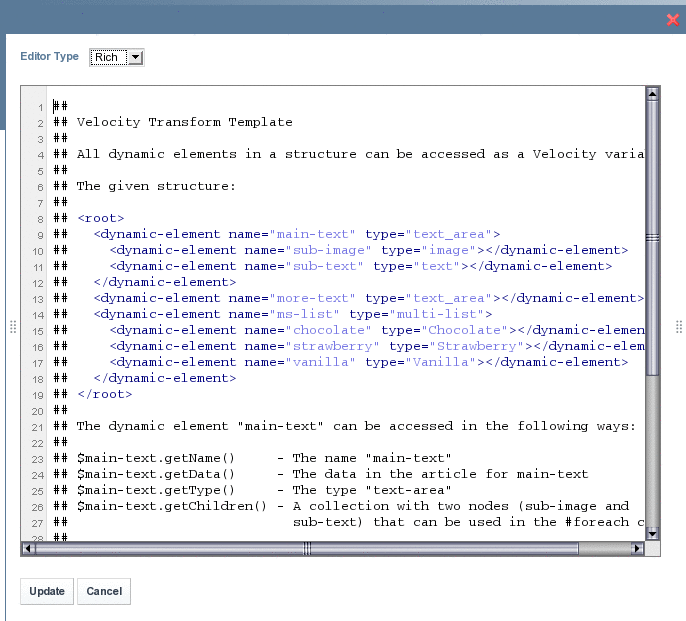
-
Click on the Update button, after making changes to the template.
-
-
To make use of an existing template:
-
Select a language from the Language Type list.
VM, SXL, and CSS are the available language options.
-
Click on the Browse button against the Script field to browse an existing template.
-
Select the Format Script checkbox.
-
Click Launch Editor to open the browsed script
-
Click on the Update button, after making changes to the script.
-
-
If you find it to be necessary, Add a small image to represent the template in the description field,
You can , enter the URL path for an image in the Small Image URL field, or you can browse an image by using the Browse button. To use the image in the template, select the Use Small Image checkbox.
-
Click Save.
 To Edit a Template
To Edit a Template
-
Click on the Actions button against the template, and select Edit from the menu.
Before editing the actual template, it is advisable to view the associated articles because their layout will be affected by any changes made to your structure. After editing the template, you can view these articles with the new template layout. You can click View Articles from the Action menu to view associated articles.
Figure 4–40 To edit a Template

-
Edit the template as desired.
In the edit screen, you can edit anything in the template except for the template ID, which can not be changed once the template has been created.
Figure 4–41 To edit a Template
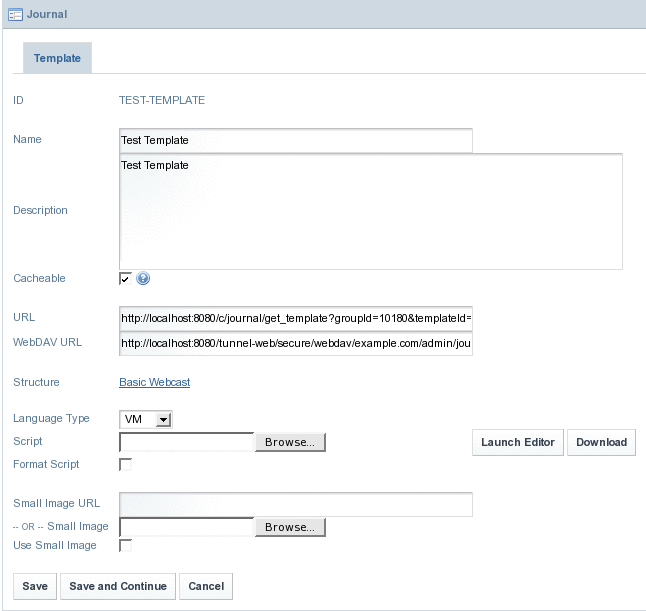
-
Click Save.
 To Delete a Template
To Delete a Template
-
To delete a template, you must first delete all the articles associated with that template.
To delete all articles, click on the Actions button and select View Articles from the menu.
Figure 4–42 To delete a Template
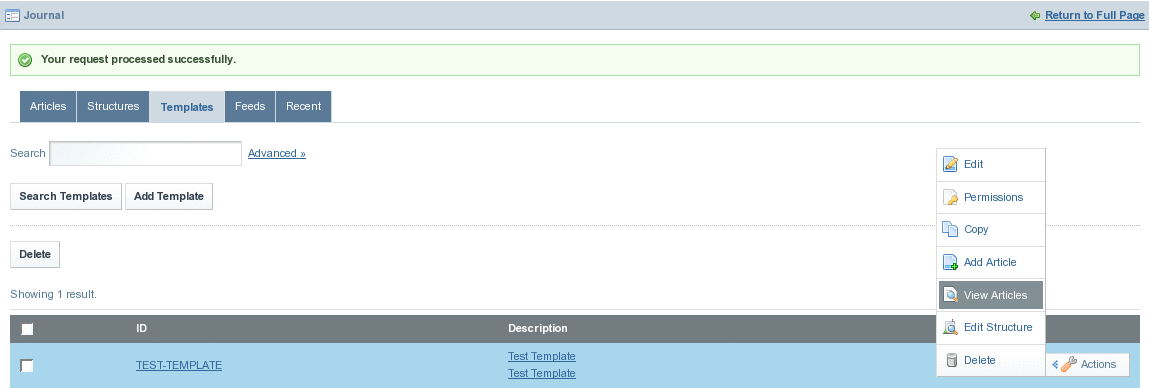
All the articles associated with the Template are listed.
Figure 4–43 To delete a Template

-
Select all articles, and click on the Delete button.
A dialog-box with the message “Are you sure you want to delete the selected articles?” appears. Click OK to delete all articles.
Figure 4–44 To delete a Template

-
Click on the Templates tag once again.
Select the template and click Delete.
Figure 4–45 To delete a Template
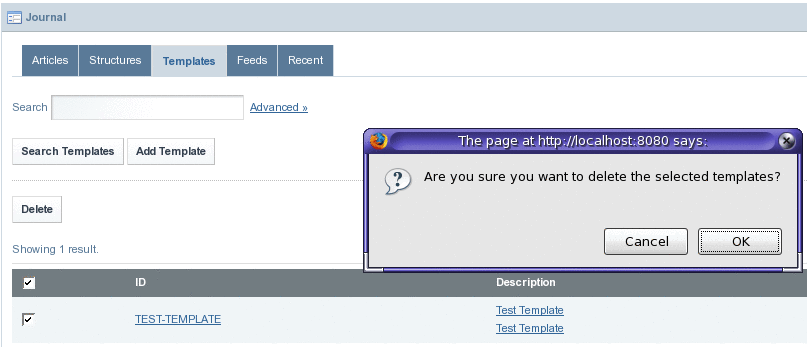
Click OK on the dialog-box for confirming delete operation to delete the template.
Articles
 To Create an Article
To Create an Article
-
Login to WebSynergy.
-
Click Add Applications and expand the CMS folder.
-
Click Add against Journal portlet.
The Journal portlet is added to your page.
-
Click on the Articles tab.
All Journal articles are listed.
Figure 4–46 To create an Article
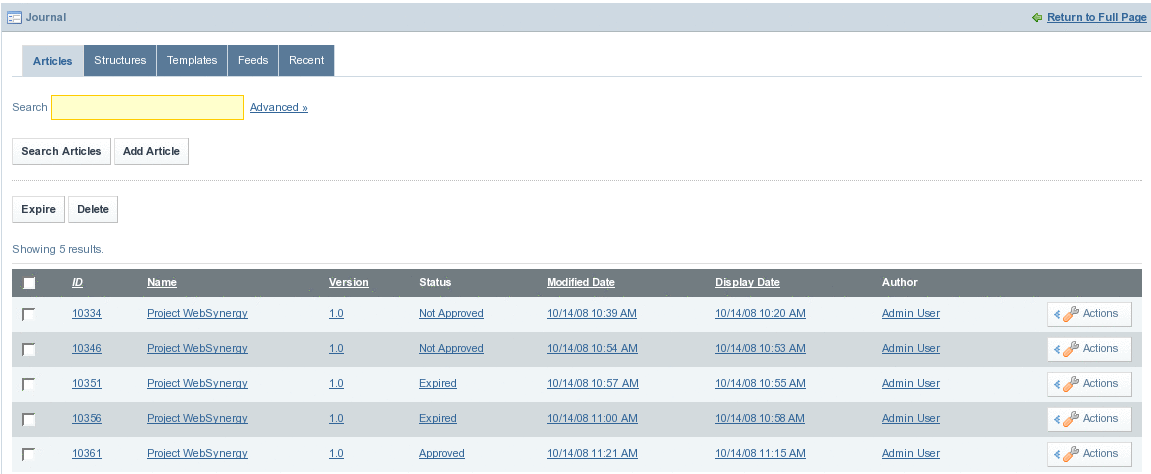
-
To create a new Journal Article, click on the Add Article button.
Figure 4–47 To create an Article
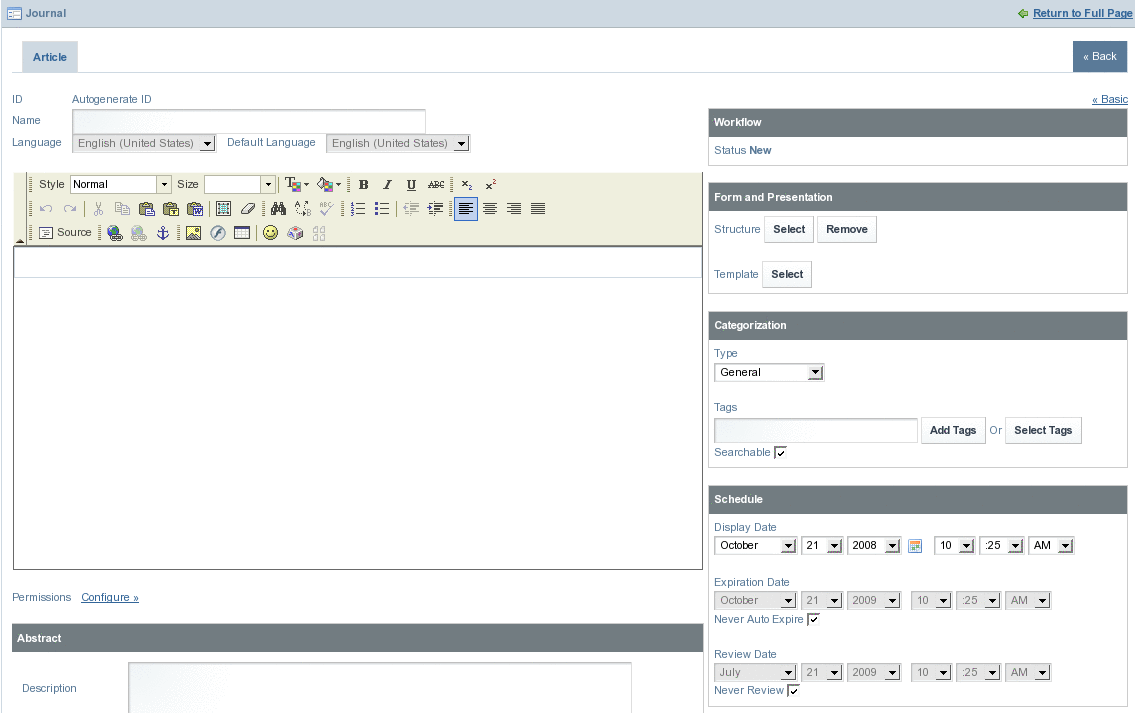
-
To select a Structure and a Template for the article, click on the Select button beside the Structure field.
You find the option to select a structure under Farm and Presentation.
Figure 4–48 To create an Article
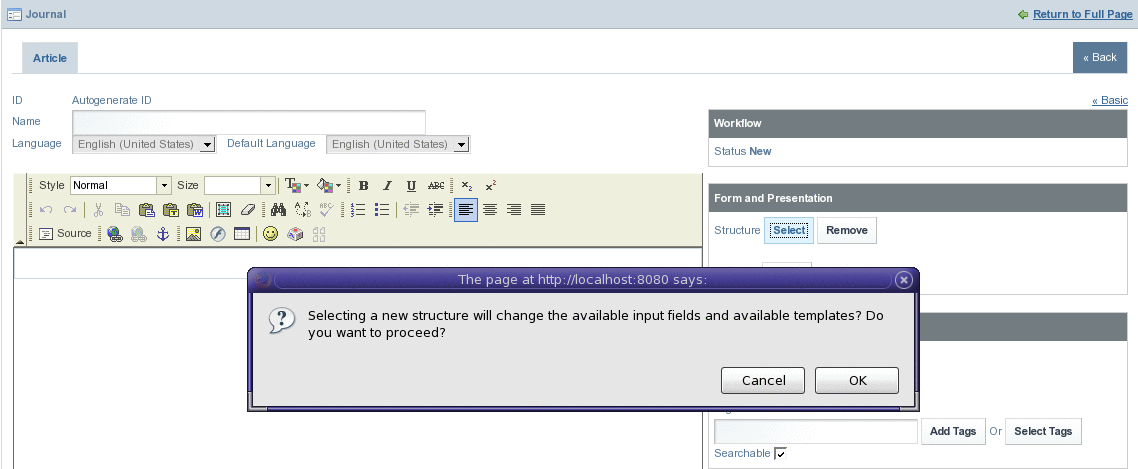
A dialog box appears with the message “Selecting a new structure will change the available input fields and available templates? Do you want to proceed?” appears. Click OK. The Structures window appears. You can select a structure by clicking on the name of a Structure. In our example, click on BASIC-WEBCAST to make it the Structure for the article.
You can note that the structure of the article has changed.
Figure 4–49 To create an Article

If there is a template using the structure, the template is added to the article by default.
-
Specify a name for the article.
-
Choose the Type for Categorization that the article will reside in.
Figure 4–50 To create an Article
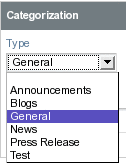
This will help make it easier for users to make manual searches of articles and organize articles.
-
Set the Schedule details.
Set values for Display Date, Expiration Date, and Review Date fields. The default setting does not set an expiration date and review date.
Figure 4–51 To create an Article
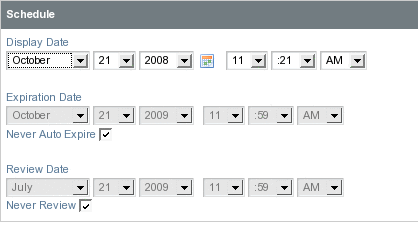
-
Create the article, and click Save.
 To Edit an Article
To Edit an Article
-
Click on the Actions button for the article and select Edit from the menu.
Figure 4–52 To edit an Article
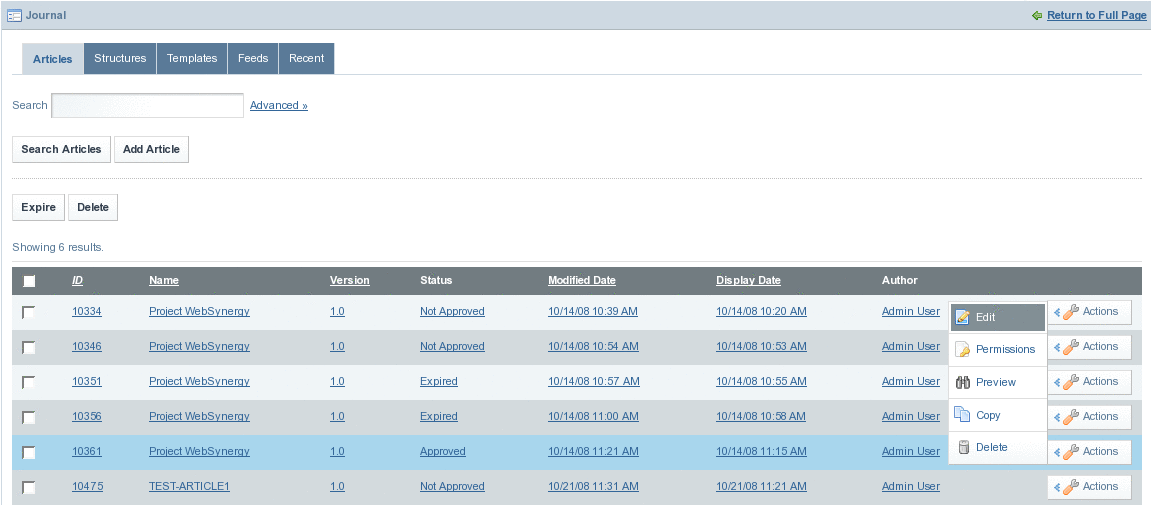
The article appears in Edit mode. In this screen you can edit anything in the article except for the article ID, which can not be changed once the article has been created. You can choose to increment the version every time you edit the article to help all users see how often the article has been changed. If you feel that the changes you are making are very minor, you can choose not to increment it. Note that if you set the expiration date to a date earlier to the current date, you will no longer be able to select that article for use in the Journal Content portlet.
-
Make necessary changes and click Save.
 To Delete an Article
To Delete an Article
- © 2010, Oracle Corporation and/or its affiliates
